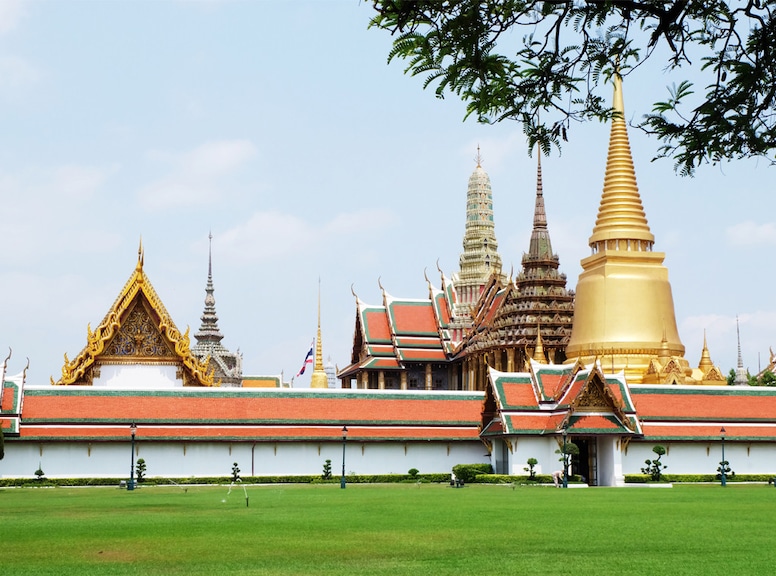Grand Palace, Bangkok, Thailand
Construction of the palace began in May 1782 at the order of King Phutthayotfa Chulalok, the founder of the Chakri Dynasty. The complex network of buildings and gardens is surrounded by four walls and covers an area of about 2,351,000 square feet.
Neuschwanstein Castle, Bavaria, Germany
Neuschwanstein, which means "New Swanstone Castle," is a 19th-century Romanesque Revival palace commissioned by Ludwig II of Bavaria as a retreat and as a homage to Richard Wagner. The castle was intended as a home for the king, until he died in 1886. Had it been completed, the palace would have had more than 200 interior rooms. Still, the total floor space of all floors amounts to nearly 65,000 square feet and the palace's tallest tower reaches a staggering altitude of 3,307 feet.
Winter Palace, St. Petersburg, Russia
From 1732 to 1917, the Winter Palace was the official residence of the Russian monarchs. Its immense size was intended to reflect the power of Imperial Russia. The Winter Palace has been calculated to contain 1,786 doors, 1,945 windows, 1,500 rooms and 117 staircases.
Palacio Real, Madrid, Spain
The massive Palacio Real has a whopping 1,450,000 square feet of floor space and contains 3,418 rooms. The last Spanish monarch to continuously live in the palace was King Alfonso XIII who ruled from 1886 to 1931.
Summer Palace, Beijing, China
The origins of the Summer Palace date back to the Jurchen-led Jin dynasty in 1153 when the fourth ruler, Wanyan Liang (r. 1150–1161), ordered the construction of a palace. Today, the buildings and water reservoir cover an area of 1.1 square miles.
Windsor Castle, Windsor, England
The Berkshire castle was built by William the Conqueror in the 1070s. Today, the Queen still hosts events on the premises and more than 500 people live and work at the castle, making it the most inhabited castle in the world. It's also the burial site of 10 monarchs.
Rundale Palace, Latvia
Built for the Dukes of Courland, construction on Rundale began in 1736. Today, the palace and its surrounding gardens are one of the major tourist destinations in Latvia.
Schonbrunn Palace, Vienna, Austria
Built in the early 1700s, the palace is one of the most important architectural monuments in the world and is one of the largest tourist attractions in Vienna. It includes the oldest zoo in the world as well as a maze and a labyrinth.
Buckingham Palace, London, England
This has remained the London home for British Royals since 1837. Notably one of the 10 most beautiful palaces in the world, it is located in the City of Westminster and consists of 775 rooms and is the central location for British people during times of national rejoicing and times of crisis.
Mysore Palace, India
Mysore is the official residence of the Wadiyar dynasty and the seat of the Kingdom of Mysore. The current structure was constructed between 1897 and 1912 after the Old Palace was burned down.
Alhambra, Granada, Spain
Originally a small fortress, the structure didn't resemble it's current formation until the mid-13th century when the Nasrid emir Mohammed ben Al-Ahmar of the Emirate of Granada renovated it into a massive palace. In 1492, the site became the Royal Court of Ferdinand and Isabella where Christopher Columbus received royal endorsement for his expedition. The palace covers an area of about 1,530,000 square feet or 35 acres.
Luxembourg Palace, Ile-de-France, France
Luxembourg was originally built (1615–1645) to be the royal residence for the regent Marie de' Medici, mother of Louis XIII of France. Since 1958 it has been the seat of the French Senate.
Kensington Palace, London England
Located in the fashionable Royal Borough of Kensington and Chelsea in London, the palace is the primary residence for many of the British monarchs and is best known for being the childhood home of Queen Victoria. Today, it is the official London residence of Prince William and Kate Middleton, Prince Harry and more. The property includes rolling gardens, fountains and plenty of history related to the monarchy.
Château de Chambord, Loir-et-Cher, France
Constructed by King Francis I, the French chateau is famous for its Renaissance architecture, mixing traditional French medieval artwork with classical Renaissance structures. It is surrounding by a moat with 440 rooms, 282 fireplaces and 84 staircases.
Palace of Versailles, France
This was originally built as a hunting lodge for King Louis XIII and was turned into a small village during the time period. It has since become one of the most beautiful palaces in the world, especially due to its extravagant gardens—one of the finest extant examples of the Jardin à la française created by André Le Nôtre.
Pena Palace, Sintra, Portugal
The palace's history dates back to the Middle Ages when it was just a small chapel and monastery until the structure was destroyed by an earthquake in 1755. In 1838, King consort Ferdinand II acquired the land and remaining structures to transform them into a palace that would serve as a summer residence for the Portuguese royal family.
Forbidden City, Beijing, China
Built from 1406 to 1420, the city complex consists of a mind-blowing 980 buildings and covers over 180 acres. It served as the former Chinese imperial palace and the center of Chinese government from the Ming dynasty to the end of the Qing dynasty from 1420 to 1912, nearly 500 years!
Chateau Frontenac, Quebec, Canada
OK, so Quebec's Chateau Frontenac was never a home to royals, but it should have been! The breathtaking building has served as one of Canada's most famous hotels since it was built in 1893. Today, the hotel capacity is more than 600 rooms on 18 floors.

